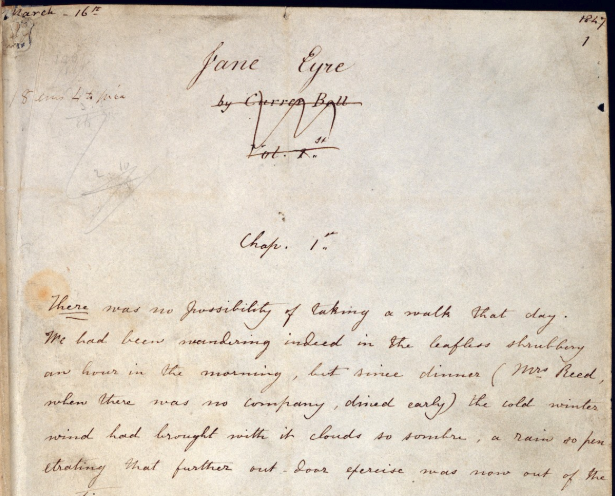
The British Library in London, with St. Pancras station in the background.Patche99z / Creative Commons
A British Library curator chooses the institution's most valuable items along with the treasures she most enjoys.
Editor's note: Originally published in May 2017.
“It isn’t just a place to do research; we have all kinds of gems here: printed books and maps and illustrated manuscripts,” British Library curator Zoë Wilcox tells British Heritage Travel.
“The Magna Carta is right there,” she adds brightly, casually pointing to one history’s most important documents.
We asked Wilcox to prove her point by choosing a few of her favorite objects in the library’s collections—not necessarily the most valuable things but rather items she just enjoys.
“It was incredibly difficult to narrow it down to just five,” she admits, “but there are some pieces I just had to include.”
Charlotte Brontë’s manuscript for Jane Eyre

The first page of Charlotte Brontë’s manuscript of Jane Eyre, 1847.
“Jane Eyre was always one of my favorite books, so it was a great thing to see the real manuscript when I came to work at the library. We’ve got these three volumes that Charlotte Brontë submitted to her publisher. What’s really lovely about them is that they have her annotations in there that serve to make Jane into a stronger character. It’s really nice to see that she made these last-minute decisions to make Jane more independent and stronger willed.”
A stage plot for a lost Elizabethan play The Dead Man's Fortune
"They’re really rare. There are only six and we’ve got five at the library. And The Dead Man’s Fortune is the one that is in the best condition. It is complete, whereas the others are mostly fragmentary, so it’s really special that we’ve still got this one. The fact that it was actually hung backstage at an Elizabethan playhouse is, I think, pretty cool. Richard Burbage would have been backstage looking at this, seeing when he had to go on. It’s this really amazing direct link back to this moment in the early 1590s.”
Anyone with a reader’s pass can order this item and look at it in the British Library Manuscripts Reading Room.
Nazi map of west European immigrants living in the USA
G. Hulbe, Einwanderer erster und zweiter Generation aus Mittel- und Westeuropa. Stuttgart-Hamburg, c.1940
“This is a map produced by the Nazis in 1940 when Joseph Goebbels was the Minister of Propaganda. They were looking for first and second-generation immigrants living in the states. What is quite extraordinary is what they then did with this statistical information. Having produced the map which had a little pie chart for every state showing how many western European immigrants there were in each area, they identified the best places to put propaganda adverts in the local press, basically trying to convince America not to enter the war. They were kind of playing into the isolationist tactics that were going on at the time."
The Story of the Learned Pig, by an Officer of the Royal Navy. London, 1786
"Well, we came across this book about Shakespeare while we were researching the exhibition [Shakespeare in Ten Acts]. This was one of the earliest example we’ve found of someone who was having great fun with the story of Shakespeare’s life with this alternative version in which some of Shakespeare’s plays were authored by a strange character--a kind of reincarnated pig. It’s something James Shapiro mentioned in his book Contested Will where he’s talking about the authorship debate and how it started. I think opinions differ as to whether this was in any way a sign of Shakespeare’s authorship being seriously questioned. Nobody took it that seriously at the time, but it was the first, of one of many, takes on Shakespeare’s authorship."
The Story of the Learned Pig can be ordered and seen in the British Library Rare Books and Music Reading Room.
A short introduction for to learn to swim, Christopher Middleton. London, 1595.
“It’s the first printed guide to any sort of sport published in English. It was published in 1595 and is one of these woodcuts with very funny illustrations. There’s one called ‘To Turn in the Water Like a Roach’ and another titled ‘To Hang by the Chin in the Water.’ And it contains these little handwritten notes in the margins: ‘Is not ye water cold?’ and ‘I cannot get on my hoses!’”
Read more
* Originally published in May 2017.





Comments